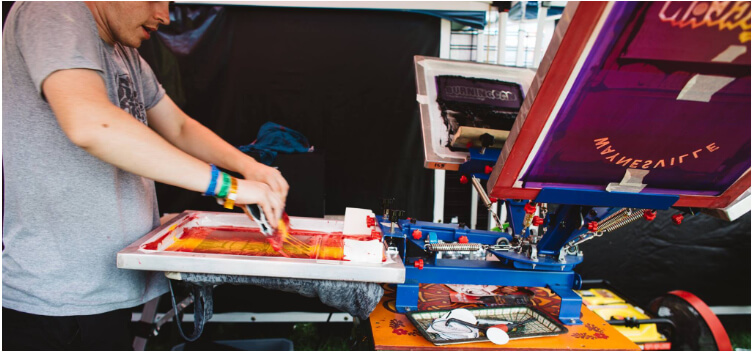Direct to Garment vs. Screen Printing
Among the many services we provide at Asheville Print Shop & Screen Printing, some of the most fun services we offer here is t-shirt printing. From this we have two methods of printing, screen printing and direct-to-garment. But what many clients may ask is, what is the difference between screen printing and direct-to-garment? These two printing methods are both very popular methods of printing design onto fabric. However they are both very different in their processes. At Asheville Print Shop & Screen Printing we offer both services to you at your convenience. To help you decide which is the best route for you let’s first take a look into what each method calls for.

Direct to garment printing is a shirt printing method that involves a digital printer and can apply multiple colors at once. A special ink is used for the digital printer in order for the fibers of a garment to absorb the color. The benefits of direct-to-garment is the versatility in color options and no minimums. That means we can do as little as 1 t-shirt with a ton of colors. Since colors are not applied one at a time like traditional screen printing, this allows for a wide range of colors to be used on your design and also allows for the use of photographs for your prints. Since direct-to-garment is like printing with a digital printer, more detail and depth can be used in a design compared to screen printing. The direct-to-garment printer we use is the Epson F2000 which allows us to print large t-shirt designs up to 16”x20”. It works best with 100% cotton blend shirts and also 50/50 blend shirts and has precision dot control for a more clear and sharp image. The Epson F2000 also has a print resolution of up to 1440×720 for color prints and 1440×1440 for white prints. It also allows us to view your print job while it is printing so we can make sure that it looks exactly how you want it.

Screen printing is a method of printing where ink is pushed through a silk screen and a squeegee is dragged across the screen to help pull the ink back and push it down to the fabric. Before printing onto a garment a screen must be made. Screen printing is different from direct-to-garment because there is no digital printer that applies the ink onto the fabric. A screen is made in order to place a design onto a shirt. For certain designs, multiple screens are required to apply different colors. Since designs are applied manually instead of digitally, there is more versatility to design placement on your shirt or fabric. With screen printing, details cannot reach the capacity that a digital printer can get to with images like photographs. Designs that work best with screen printing are those that require basic shapes or illustrated images. However with screen printing, designs last longer and can withstand machine washes much longer since the ink is heat dried.
When taking in the factor of pricing, it all depends on the size of your order. Direct-to-garment printing is more cost-effective for small orders since there is no setup time required and it does not require a big up front investment. Direct-to-garment isn’t recommended, however, as an order becomes larger lets say more than 30 – 100 pieces. Each job is different so we would look at the art, placements and colors to determine which method will be best for each job. Screen-printing is more cost-effective for larger orders and pretty common in wholesale printing. With screen printing, the larger the order the better the discount you get per shirt! However, regardless of the size of your order, large or small orders, Asheville Print Shop & Screen Printing is here to help you choose the right method. Stop by our print shop off Patton Avenue so we can talk more about the right print method that suits your design and needs!
Jacob is the Founder and CEO of Asheville Print Shop & Screen Printing. When not working and dreaming of print, Jacob enjoys hiking, reading, exercising and enjoying the amazing food and beer in Asheville. An entrepreneur since childhood, Jacob is passionate about entrepreneurship and small businesses. To learn more about Jacob, check out www.JacobBallard.com


